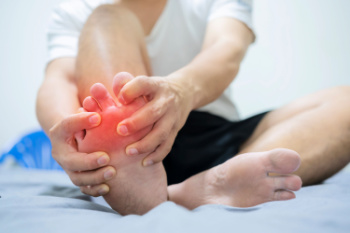Connect With Us
Blog
Items filtered by date: August 2024
Essential Diabetic Foot Care

Diabetes is a chronic condition that affects the body's ability to regulate blood sugar levels, often leading to complications in the feet. High blood sugar can damage blood vessels and nerves, reducing circulation and sensation in the feet. This makes individuals with diabetes more susceptible to foot injuries and infections, as they may not feel wounds or pressure sores developing. If not properly treated, even minor foot injuries can lead to serious complications, such as ulcers, infections, or in severe cases, amputation. Proper diabetic foot care includes regular inspection of the feet for cuts, blisters, or sores, keeping the feet clean and dry, and wearing properly fitted shoes to avoid friction. Preventive measures like controlling blood sugar levels, regular foot check-ups with a podiatrist, and proper foot hygiene are imperative to avoiding serious complications and maintaining overall foot health. If you have diabetes and notice a foot wound, it is essential to see a podiatrist promptly to prevent an infection.
Diabetic foot care is important in preventing foot ailments such as ulcers. If you are suffering from diabetes or have any other concerns about your feet, contact one of our podiatrists from Palm Beach Foot & Ankle. Our doctors can provide the care you need to keep you pain-free and on your feet.
Diabetic Foot Care
Diabetes affects millions of people every year. The condition can damage blood vessels in many parts of the body, especially the feet. Because of this, taking care of your feet is essential if you have diabetes, and having a podiatrist help monitor your foot health is highly recommended.
The Importance of Caring for Your Feet
- Routinely inspect your feet for bruises or sores.
- Wear socks that fit your feet comfortably.
- Wear comfortable shoes that provide adequate support.
Patients with diabetes should have their doctor monitor their blood levels, as blood sugar levels play such a huge role in diabetic care. Monitoring these levels on a regular basis is highly advised.
It is always best to inform your healthcare professional of any concerns you may have regarding your feet, especially for diabetic patients. Early treatment and routine foot examinations are keys to maintaining proper health, especially because severe complications can arise if proper treatment is not applied.
If you have any questions please feel free to contact our offices located in Boynton Beach, Palm Beach Gardens, and West Palm Beach, FL . We offer the newest diagnostic and treatment technologies for all your foot and ankle needs.
It's Time for Beautiful Feet
Common Causes of Joint Pain in the Big Toe

Joint pain in the big toe can be caused by several conditions. One of the most frequent causes is gout, a type of arthritis resulting from a buildup of uric acid crystals in the joint, leading to intense pain and swelling. Another common cause is bunions, where a bony bump forms at the base of the big toe, causing pain and misalignment. Arthritis, including osteoarthritis and rheumatoid arthritis, can also affect the big toe joint, causing stiffness and discomfort. Trauma or injuries, such as fractures or sprains, may contribute to joint pain as well. Identifying the underlying cause is vital for effective treatment, which may include medication, wearing proper footwear, and in some cases, surgical intervention. Pain in the big toe can cause difficulty in completing daily activities. If you have developed this type of pain, it is suggested that you consult with a podiatrist who can effectively diagnose and treat toe pain.
Toe pain can disrupt your daily activities. If you have any concerns, contact one of our podiatrists of Palm Beach Foot & Ankle. Our doctors can provide the care you need to keep you pain-free and on your feet.
What Causes Toe Pain?
Most severe toe pain is caused due to a sports injury, trauma from dropping something heavy on the toe, or bumping into something rigid. Other problems can develop over time for various reasons.
Toe pain can be caused by one or more ailments. The most common include:
- Trauma
- Sports injury
- Wearing shoes that are too tight
- Arthritis
- Gout
- Corns and calluses
- Hammertoe
- Bunions
- Blisters
- Ingrown toenails
- Sprains
- Fractures (broken bones)
- Dislocations
When to See a Podiatrist
- Severe pain
- Persistent pain that lasts more than a week
- Signs of infection
- Continued swelling
- Pain that prevents walking
Diagnosis
In many cases the cause of toe pain is obvious, but in others, a podiatrist may want to use more advanced methods to determine the problem. These can range from simple visual inspections and sensation tests to X-rays and MRI scans. Prior medical history, family medical history, and any recent physical traumatic events will all be taken into consideration for a proper diagnosis.
Treatment
Treatments for toe pain and injuries vary and may include shoe inserts, padding, taping, medicines, injections, and in some cases, surgery. If you believe that you have broken a toe, please see a podiatrist as soon as possible.
If you have any questions please feel free to contact our offices located in Boynton Beach, Palm Beach Gardens, and West Palm Beach, FL . We offer the newest diagnostic tools and technology to treat your foot and ankle needs.
Biomechanical Foot Assessment
 A biomechanical assessment of the foot and ankle is a detailed evaluation conducted to understand the movement patterns and structural alignment of these areas. This assessment involves examining how the foot and ankle move during various activities, such as walking or running and identifying any abnormalities or dysfunctions. The primary purpose of a biomechanical assessment is to diagnose issues that may cause pain, discomfort, or impaired function. Common conditions identified through this process can include flat feet, overpronation, supination, and alignment issues affecting the knees, hips, and lower back. The assessment typically includes visual and physical examinations, gait analysis, and sometimes advanced imaging techniques. Conducting a biomechanical assessment is important for developing personalized treatment plans. It helps in prescribing appropriate orthotics, footwear, and exercises to correct identified problems. This evaluation is essential for athletes, individuals with chronic pain, and those recovering from injuries. If you have chronic foot or ankle pain, it is suggested that you visit a podiatrist for a biomechanical assessment and treatment based on results.
A biomechanical assessment of the foot and ankle is a detailed evaluation conducted to understand the movement patterns and structural alignment of these areas. This assessment involves examining how the foot and ankle move during various activities, such as walking or running and identifying any abnormalities or dysfunctions. The primary purpose of a biomechanical assessment is to diagnose issues that may cause pain, discomfort, or impaired function. Common conditions identified through this process can include flat feet, overpronation, supination, and alignment issues affecting the knees, hips, and lower back. The assessment typically includes visual and physical examinations, gait analysis, and sometimes advanced imaging techniques. Conducting a biomechanical assessment is important for developing personalized treatment plans. It helps in prescribing appropriate orthotics, footwear, and exercises to correct identified problems. This evaluation is essential for athletes, individuals with chronic pain, and those recovering from injuries. If you have chronic foot or ankle pain, it is suggested that you visit a podiatrist for a biomechanical assessment and treatment based on results.
If you have any concerns about your feet, contact one of our podiatrists from Palm Beach Foot & Ankle. Our doctors can provide the care you need to keep you pain-free and on your feet.
Biomechanics in Podiatry
Podiatric biomechanics is a particular sector of specialty podiatry with licensed practitioners who are trained to diagnose and treat conditions affecting the foot, ankle and lower leg. Biomechanics deals with the forces that act against the body, causing an interference with the biological structures. It focuses on the movement of the ankle, the foot and the forces that interact with them.
A History of Biomechanics
- Biomechanics dates back to the BC era in Egypt where evidence of professional foot care has been recorded.
- In 1974, biomechanics gained a higher profile from the studies of Merton Root, who claimed that by changing or controlling the forces between the ankle and the foot, corrections or conditions could be implemented to gain strength and coordination in the area.
Modern technological improvements are based on past theories and therapeutic processes that provide a better understanding of podiatric concepts for biomechanics. Computers can provide accurate information about the forces and patterns of the feet and lower legs.
Understanding biomechanics of the feet can help improve and eliminate pain, stopping further stress to the foot.
If you have any questions please feel free to contact our offices located in Boynton Beach, Palm Beach Gardens, and West Palm Beach, FL . We offer the newest diagnostic and treatment technologies for all your foot and ankle needs.
Facts About Achilles Tendinitis
 Achilles tendonitis is an inflammatory condition affecting the largest tendon in the body, which connects the calf muscles to the heel bone. Inflammation of the Achilles tendon often results from repetitive stress and overuse. It is particularly common in athletes or individuals who engage in activities involving intense running, jumping, or abrupt movements. Symptoms typically include pain and stiffness along the tendon, especially in the morning or after periods of inactivity, and swelling or tenderness. To manage Achilles tendinitis, it is important to reduce activities that cause or increase the pain. Resting and taking anti-inflammatory medications can help alleviate symptoms. Stretching and strengthening exercises for the calf muscles are also beneficial in promoting flexibility and support. Wearing supportive footwear or orthotics can provide additional relief by reducing strain on the Achilles tendon. If you have this condition and it persists or worsens, it is suggested that you schedule an appointment with a podiatrist.
Achilles tendonitis is an inflammatory condition affecting the largest tendon in the body, which connects the calf muscles to the heel bone. Inflammation of the Achilles tendon often results from repetitive stress and overuse. It is particularly common in athletes or individuals who engage in activities involving intense running, jumping, or abrupt movements. Symptoms typically include pain and stiffness along the tendon, especially in the morning or after periods of inactivity, and swelling or tenderness. To manage Achilles tendinitis, it is important to reduce activities that cause or increase the pain. Resting and taking anti-inflammatory medications can help alleviate symptoms. Stretching and strengthening exercises for the calf muscles are also beneficial in promoting flexibility and support. Wearing supportive footwear or orthotics can provide additional relief by reducing strain on the Achilles tendon. If you have this condition and it persists or worsens, it is suggested that you schedule an appointment with a podiatrist.
Achilles tendon injuries need immediate attention to avoid future complications. If you have any concerns, contact one of our podiatrists of Palm Beach Foot & Ankle. Our doctors can provide the care you need to keep you pain-free and on your feet.
What Is the Achilles Tendon?
The Achilles tendon is a tendon that connects the lower leg muscles and calf to the heel of the foot. It is the strongest tendon in the human body and is essential for making movement possible. Because this tendon is such an integral part of the body, any injuries to it can create immense difficulties and should immediately be presented to a doctor.
What Are the Symptoms of an Achilles Tendon Injury?
There are various types of injuries that can affect the Achilles tendon. The two most common injuries are Achilles tendinitis and ruptures of the tendon.
Achilles Tendinitis Symptoms
- Inflammation
- Dull to severe pain
- Increased blood flow to the tendon
- Thickening of the tendon
Rupture Symptoms
- Extreme pain and swelling in the foot
- Total immobility
Treatment and Prevention
Achilles tendon injuries are diagnosed by a thorough physical evaluation, which can include an MRI. Treatment involves rest, physical therapy, and in some cases, surgery. However, various preventative measures can be taken to avoid these injuries, such as:
- Thorough stretching of the tendon before and after exercise
- Strengthening exercises like calf raises, squats, leg curls, leg extensions, leg raises, lunges, and leg presses
If you have any questions please feel free to contact our offices located in Boynton Beach, Palm Beach Gardens, and West Palm Beach, FL . We offer the newest diagnostic tools and technology to treat your foot and ankle needs.

